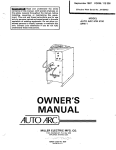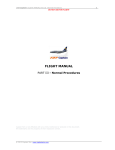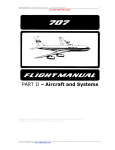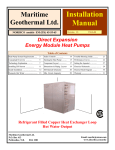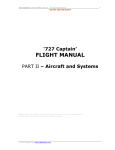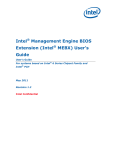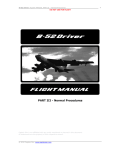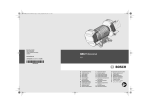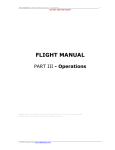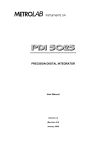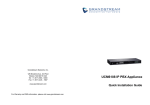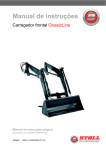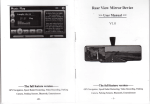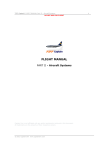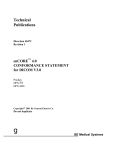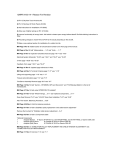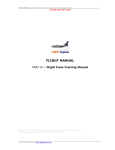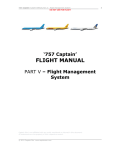Download `707 Captain` FLIGHT MANUAL Part III – Operations
Transcript
‘707 Captain’ FLIGHT MANUAL Part III – Normal Procedures DO NOT USE FOR FLIGHT PART III - Normal Procedures Captain Sim is not affiliated with any entity mentioned or pictured in this document. All trademarks are the property of their respective owners. © 2010 Captain Sim www.captainsim.com 1 ‘707 Captain’ FLIGHT MANUAL Part III – Normal Procedures DO NOT USE FOR FLIGHT 2 ABOUT THIS MANUAL VERSION: 19 OCTOBER, 2010 WARNING: THIS MANUAL IS DESIGNED FOR MICROSOFT® FSX USE ONLY. DO NOT USE FOR FLIGHT. The ‘707 Captain’ FLIGHT MANUAL is organized into three Parts. Each Part is provided as a separate Acrobat® PDF document: Click START > Programs > Captain Sim > 707 Captain > • Part I – User’s Manual • Part II – Aircraft Systems • Part III – Normal Procedures - this document. Adobe Acrobat® Reader Required FOR GENERAL INFORMATION ON THE ‘707 CAPTAIN’ PRODUCT PLEASE USE WWW.CAPTAINSIM.COM . THIS MANUAL PROVIDES ADDITIONAL INFORMATION ONLY, WHICH IS NOT AVAILABLE ON THE WEB SITE. © 2010 Captain Sim www.captainsim.com ‘707 Captain’ FLIGHT MANUAL Part III – Normal Procedures DO NOT USE FOR FLIGHT 707-300 FLIGHT MANUAL PART III – NORMAL PROCEDURES CONTENTS Page 5 NORMAL CHECKLIST 5 5 5 5 6 6 6 6 6 BEFORE START CLEARED FOR START AFTER START BEFORE TAKEOFF CLEARED FOR TAKEOFF AFTER TAKEOFF AFTER LANDING SHUTDOWN TERMINATING FLIGHT 7 NORMAL PROCEDURES: GENERAL INFORMATION 7 SCAN FLOW PATTERNS 10 NORMAL PROCEDURES: PREFLIGHT 10 10 10 11 17 18 20 21 22 23 24 25 GENERAL EXTERIOR SAFETY INSPECTION COCKPIT SAFETY INSPECTION PRELIMINARY COCKPIT PREPARATION COCKPIT PREPARATION - FLIGHT ENGINEER COCKPIT PREPARATION - CAPTAIN COCKPIT PREPARATION – FIRST OFFICER COCKPIT PREPARATION - NAVIGATOR AMPLIFIED BEFORE START CHECKLIST ENGINE START PROCEDURE AFTER START PROCEDURE AMPLIFIED AFTER START CHECKLIST 25 TAXI-OUT AND TAKEOFF 25 27 29 30 31 32 33 TAXI-OUT PROCEDURE AMPLIFIED BEFORE TAKEOFF CHECKLIST TAKEOFF PROCEDURE REJECTED TAKEOFF PROCEDURE ENGINE FIRE/FAILURE AFTER V1 AFTER TAKEOFF PROCEDURE AMPLIFIED AFTER TAKEOFF CHECKLIST 34 CLIMB PROCEDURE 37 CRUISE PROCEDURE 37 DESCENT - APPROACH PROCEDURE 39 AMPLIFIED DESCENT - APPROACH CHECKLIST 41 LANDING PROCEDURE 42 43 44 AMPLIFIED LANDING CHECKLIST GO-AROUND PROCEDURE LANDING ROLL PROCEDURE © 2010 Captain Sim www.captainsim.com 3 ‘707 Captain’ FLIGHT MANUAL Part III – Normal Procedures DO NOT USE FOR FLIGHT 45 TAXI-IN AND PARK 45 46 46 47 AFTER LANDING PROCEDURE AMPLIFIED AFTER LANDING CHECKLIST PARKING PROCEDURE AMPLIFIED SHUTDOWN CHECKLIST 49 PERFORMANCE TABLES 49 50 TAKEOFF SPEEDS CRITICAL SPEEDS 51 FLIGHT PATTERNS 51 52 53 54 55 56 57 NORMAL TAKEOFF NOISE ABATEMENT TAKEOFF TAKEOFF – ENGINE FIRE/FAILURE AFTER V1 NORMAL OR ONE ENGINE INOPERATIVE VOR APPROACH NORMAL OR ONE ENGINE INOPERATIVE ILS APPROACH ILS AUTOPILOT NORMAL OR ONE ENGINE INOPERATIVE LANDING 58 CUSTOMER SUPPORT © 2010 Captain Sim www.captainsim.com 4 ‘707 Captain’ FLIGHT MANUAL Part III – Normal Procedures DO NOT USE FOR FLIGHT NORMAL CHECKLIST BEFORE START Cockpit Preparation COMPLETE Interphone CHECKED, ON & ALL Emergency Flaps OFF Anti-Skid CHECKED & ON Rudder & Spoiler Switches. . ON Emergency Exit Lights ARMED Seat Belts Switches ON F/O – INS CHECKED & SET Radio Altimeter CHECKED Window Heat LOW Pneumatic Brake CHECKED Fit Inst, Altimeter & Fit Dir. SET& X-CHECKED Compasses SYNC & X-CHECKED Radios, Radar & Transponder SET & STANDBY Start Levers CUTOFF Parking Brakes SET Rudder & Aileron Trim FREE & ZERO Battery ON Fuel KGS, SET FOR START Air Cond Units OFF ALL С С С CrF/0 F/O F/O С ALL C,F/0 С, F/O С С С F/E F/E F/E CLEARED FOR START Galley Power Start Pressure INS Mode Selectors Beacon Before Start Checklist OFF F/E PSI F/E Doppler С ON С COMPLETEF/O AFTER START Ground Equipment Hydraulics Doors After Start Checklist CLEAR С PRESS & QTY NORMAL, F/E INTERCONNECT CLOSED CLOSED F/E COMPLETE F/O BEFORE TAKEOFF Nacelle Anti-Ice Ground Start Switch. Window Heat Probe Heaters Fit Dir. Fit Inst & Radios. Speedbrake Lever Flaps Start Levers Stabilizer Trim Flight Controls INS Electrical Galley Power Fuel Fuel Heat Hydraulics Cockpit Door. OFF/ON F/O OFF F/O HIGH F/O ON F/O SET FOR DEPARTURE C,F/0 FULL FORWARD С 14, 14, GREEN LIGHTS С IDLE DETENT С UNITS С CHECKED С CHECKED F/O NO LIGHTS, ESS 3 F/E ON F/E SET FOR Т.О. F/E OFF F/E PRESS & QTY NORMAL F/E LOCKED F/E © 2010 Captain Sim www.captainsim.com 5 ‘707 Captain’ FLIGHT MANUAL Part III – Normal Procedures DO NOT USE FOR FLIGHT Takeoff Briefing & Data .REVIEWED, BUGS SET ALL CLEARED FOR TAKEOFF Air Cond & Press Transponder Engine Start Control Selectors Landing Lights Before Takeoff Checklist SET FOR Т.О. ON BOTH ON COMPLETE F/E F/O F/E F/O F/E AFTER TAKEOFF Anti-Ice Engine Start Control Selectors Seat Belts Switches Gear Flaps Hydraulics Air Cond & Press OFF/ON OFF/ON OFF/ON F/E UP & OFF UP, NO LIGHTS PRESS & QTY NORMAL CHECKED & SET F/E F/E OFF/ON OFF LOW/OFF OFF UP, NO LIGHTS FULL FORWARD STBY/OFF OFF 1 PUMP/ENGINE PRESS & QTY NORMAL OPEN COMPLETE F/O F/E F/O F/O F/O С F/O F/E F/E F/E F/E F/E F/E F/E F/E F/E AFTER LANDING Anti-Ice Engine Start Control Selectors . Window Heat Probe Heat Flaps Speedbrake Lever Radar & Transponder Galley Power Fuel Hydraulics Outflow Valves After Landing Checklist SHUTDOWN Electrical EXTERNAL POWER ON F/E Seat Belts Switch OFF F/E Beacon OFF F/O Exterior Lights AS REQUIRED F/O Start Levers CUTOFF С Parking Brakes RELEASED/SET С Fuel Boost Pumps OFF F/E AC Aux Pumps OFF F/E Air Cond Units OFF F/E Shutdown Checklist (Through Flight) COMPLETE F/E TERMINATING FLIGHT INS Emergency Exit Lights External Power Battery Oxygen Regulators Oxygen Valve Shutdown Checklist (Terminating Flight) © 2010 Captain Sim www.captainsim.com OFF OFF ON/OFF F/E ON/OFF OFF, 100% CLOSED F/O F/O COMPLETE F/E F/E ALL F/E 6 ‘707 Captain’ FLIGHT MANUAL Part III – Normal Procedures DO NOT USE FOR FLIGHT 7 NORMAL PROCEDURES: GENERAL INFORMATION SCAN FLOW PATTERNS Normal procedures are accomplished by recall. Normal checklists are read at specified points to verify that certain critical or essential steps of the preceding procedures have been accomplished. Where possible, these steps and checklists follow a standardized scan flow for each panel as indicated below. This provides the flight crew with established patterns for performing the normal procedures and checklists. The following charts identify the standard callouts required during CLIMB, DESCENT and FINAL APPROACH for either IFR or VFR conditions. Chart 1 contains all recommended standard callouts for a normal IFR or VFR flight. Chart 2 contains additional callouts to be made when accomplishing a category II or category IMA approach. The pilot not flying should accomplish these callouts on every flight while the flight engineer monitors. Airplanes with special alerting equipment (i.e. terrain warning, etc.) still require these callouts to be performed because these alerting systems normally monitor altitudes from the radio altimeter which can be influenced by irregular ground levels. NOTE: DO NOT use radio altimeter as the instrument for standard callout references. © 2010 Captain Sim www.captainsim.com ‘707 Captain’ FLIGHT MANUAL Part III – Normal Procedures DO NOT USE FOR FLIGHT 8 STANDARD CALLOUTS CONDITION/LOCATION CALLOUT CLIMB AND Approaching: 'Transition Altitude, Transition Altitude (IFR and Altimeters Reset" VFR) DESCENT 1000 ft above/below assigned altitude (IFR) "1000 Feet to Level Off" DESCENT 10,000 ft (MSL) (reduce airspeed) (IFR and VFR) "10,000 Feet" 1000 ft above initial approach altitude (IFR) First positive INWARD motion of localizer bar (IFR) First positive motion of glide slope bar (IFR) "1000 Feet Above Initial" FINAL APPROACH "Localizer Alive" "Glide Slope Alive" Final fix inbound (altimeter, "At Marker/VOR/NDB/, Etc. instrument and flag Time, crosscheck) (IFR) Feet, Altimeters And Instruments Crosschecked" 1000 and 500 feet above "1000/500 Feet Above Field, field elevation (altimeter, Altimeters and Instruments instrument and flag Crosschecked" crosscheck) (IFR) (VFR) After 500 ft above field elevation (IFR and VFR) 100 ft above DH or MDA (IFR) (Call out signaficant deviations from programmed airspeed, descent and instrument indications) "100 Feet Above Minimums" Reaching Decision Height - "Minimums, DH (IFR) approach/strobe/centerline lights in sight—runway (or no runway) in sight" Reaching Minimum Descent "Minimums, Altitude - MDA (IFR) approach/strobe/centerline lights in sight-runway in sight (if appropriate)" Reaching Missed Approach "MAP, Point - MAP (IFR) approach/strobe/centerline lights in sight—runway (or no runway) in sight" CHART I © 2010 Captain Sim www.captainsim.com ‘707 Captain’ FLIGHT MANUAL Part III – Normal Procedures DO NOT USE FOR FLIGHT 9 Category II And IIIA Callouts PF: Pilot Flying PNF: Pilot Not Flying STANDARD CALLOUTS CONDITION/LOCATION FINAL APPROACH CALLOUT 200 ft. above DH/AH PF: PF calls - based upon airplane drift angle. PNF starts looking for visual cues Indivudual Sequence PNF: Flasher Lights Visible "Look Left/Right/Ahead" Individual Approach PNF: Light Bars Visible Decision Bar (1000 PNF: ft. from threshold) Visible Termination Bar (If PNF: installed) "Approach" Threshold Lights Threshold" PNF: At DH - Visual PF: reference established; i.e., PNF calling "approach" At DH - Visual PF: reference not established; i.e., PNF does not call any visual cues or calls only "strobe" CHART II © 2010 Captain Sim www.captainsim.com 'Strobe" "White Bar" "Red Bar" "Contact" "Go-around" ‘707 Captain’ FLIGHT MANUAL Part III – Normal Procedures DO NOT USE FOR FLIGHT 10 NORMAL PROCEDURES: PREFLIGHT GENERAL All preflight procedures are completed prior to each originating flight. Only those items marked with an asterisk need be accom-plished on "through-flights" when there is no crew change. Any lights which are not illuminated during a system test should be checked by press-to-test. EXTERIOR SAFETY INSPECTION This inspection is performed on each originating trip or crew change before entering the airplane to ascertain that no obiously unsafe conditions exist. Chocks Landing Gear Doors IN PLACE CHECK WARNING: IF ANY GEAR DOOR IS OPEN, ENSURE RESPECTIVE DOOR RELEASE HANDLE IS IN OPEN DETENT. IF HANDLE IS IN RETRACTED POSITION AND DOOR IS OPEN, DOOR WILL CLOSE WHEN HYDRAULIC SYSTEM IS PRESSURIZED WHICH COULD RESULT IN PERSONNEL INJURY. Flight Control Surfaces CLEAR Ensure proper clearance of flight controls from all ground equipment or other obstructions. Maintenance Status & Dispatch Deviations CHECK Verify maintenance status agrees with authorized dispatch deviations. COCKPIT SAFETY INSPECTION This inspection is performed on each originating trip or crew change to ensure the cockpit controls are configured so as to permit electrical, by hydraulic and pneumatic power to be safely applied to the airplane at the proper time. Emergency Flap Switches OFF Check: Arming switch guard closed. Inboard and outboard switches off. Landing Lights Switches OFF Landing Gear Lever DOWN & IN CAUTION: LANDING GEAR LEVER SHOULD NOT BE PLACED IN OFF DURING GROUND OPERATION DUE TO POSSIBILITY OF COLLAPSING NOSE GEAR. Radar Mode Selector OFF Transponder Mode Selector STBY Galley Power Switch OFF AC Aux Pump Switches OFF Fuel Dump Panel Cover CLOSED © 2010 Captain Sim www.captainsim.com ‘707 Captain’ FLIGHT MANUAL Part III – Normal Procedures DO NOT USE FOR FLIGHT 11 PRELIMINARY COCKPIT PREPARATION (Beginning with no power on airplane) Cockpit systems and controls are checked for normal operation, and the airplane is configured for exterior inspection, if required, and engine start. * Circuit Breakers CHECK Check circuit breakers set or collared. Essential Radio Bus 1&2 OFF External Power Switch OFF *Battery Switch ON Position battery switch and check generator breaker CIRCUIT OPEN lights illuminated. Check DC volt meter indicates 24v & load meter indicates positive or zero. *External Power CHECK Check external power CONNECTED light illuminated. AC Paralleling Selector - EXTERNAL POWER Check voltage and frequency stabilized within limits. *External Power Switch ON Check PWR ON BUS light illuminates ammeter indicates load. Voltage and frequency remain stabilized within limits. *Essential Power Source Selector EXT PWR Check essential power failure warning lights extinguish Air Conditioning Units ON/OFF Essential Radio Bus 1&2 ON PILOTS' STATION Panel Lights TEST Check all panel lights can be adjusted to desired intensity. Manual Trim Wheel - TRIM MANUALLY IN BOTH DIRECTIONS Spoiler Switches GUARDS CLOSED Fire Warning TEST Engine Fire Switches - IN Transfer Switches - NORM Engine Fire Test Switch – PRESS Check engine fire warning and W/WELL FIRE warning lights illuminate. Engine Fire Test Switch - RELEASE Check engine fire warning and W/WELL FIRE warning lights extinguish. Engine Start Control Selectors Wing Anti-Ice Switch © 2010 Captain Sim www.captainsim.com OFF OFF ‘707 Captain’ FLIGHT MANUAL Part III – Normal Procedures DO NOT USE FOR FLIGHT 12 Ground Start Switch GUARD CLOSED Passenger & Personnel Accomodations Oxygen Switch NORM Seat Belts Switches ON Check chime sounds when seat belt switch positioned to ON. Emergency Exit Lights TEST & OFF Emergency Exit Lights Switch - ON Window Heat TEST & LOW OFF Window Heat Switches - LOW Overheat Lights - PRESS Check OVERHEAT lights illuminate. Window Heat Switches - OFF Check OVERHEAT lights extinguish. Window Heat Switches (if Required for Defogging) - LOW Probe Heaters TEST & OFF Probe Heater Switches - ON Check HEAT ON lights illuminate. Probe Heater Switches - OFF Check HEAT ON lights extinguish. Wing and Navigation Light Switches Pneumatic Brake ON CHECK Check pneumatic brake handle safe-tied. Thrust Reverser Operating Lights EXTINGUISHED Engine Instruments CHECK Check: EPR indicators 1.0 and bugs move freely. N1 RPM indicators zero. EGT indicators normal. Fuel flow indicators minimum indication. Landing Gear Lights TEST & SET Check: Landing GEAR warning light extinguished. Landing gear DOOR warning light extinguished (doors closed) or illuminated (doors open). Landing GEAR down lights illuminated. Flap Lever & Indicators IN AGREEMENT Total Air Temperature Indicator CHECK Check TAT OFF flag not in view. Static Air Temperature Indicator CHECK Check warning flag retracted and indication approximately ambient temperature or greater. © 2010 Captain Sim www.captainsim.com ‘707 Captain’ FLIGHT MANUAL Part III – Normal Procedures DO NOT USE FOR FLIGHT 13 Flight Engineer’s Station Panel Lights TEST & SET AC Paralleling Selector ANY GEN Check synchronization lights illuminate. Essential Power Failure Warning Lights TEST Rotate essential power source selector to any GEN position and check both essential power FAILURE lights illuminated. Rotate selector back to EXT PWR position and check lights extinguished. DC Load & Volts Selector TEST Select TR No. 3, 2 and ESS TR and check 2^-28v DC and equal load indication on DC meters at 3 & 2 positions. Leave selector in ESS TR position. Galley Power Switch ON *AC Electrical System CHECK Check: Generator drive disconnect switch guards closed & safetied. Generator drive LOW PRESSURE lights illuminated. Bus-Tie breaker CIRCUIT OPEN lights extinguished. KW/KVAR meters zero. * Fuel System TEST & SET Note initial fuel quantity indications. Fuel Quantity Gages Test Switch - PRESS & HOLD Check each tank quantity indication decreases. Fuel Quantity Gages Test Switch - RELEASE Check all quantity indicators stabilize at original indications. Check fuel totalizer quantity agrees with sum of fuel quantity indications. All Forward Boost Pump Switches - ON Check all forward LOW PRESSURE lights extinguish and all aft LOW PRESSURE lights remain illuminated. Center Tank Left Boost Pump Switch - ON (Only when tank contains fuel.) Check center tank left LOW PRESSURE light extinguishes and right LOW PRESSURE light remains illuminated. All Forward Boost Pump Switches - OFF Center Tank Left Boost Pump Switch - OFF Check all LOW PRESSURE lights illuminated. Repeat procedure for all aft boost pumps and center tank right boost pump. Tank No. 2 Aft Boost Pump Switch - ON All Crossfeed Selectors - CLOSE Check VALVE POSITION lights illuminate momentarily, then extinguish. All Crossfeed Selectors - OPEN Check VALVE POSITION lights illuminate momentarily, then extinguish Reserve Tank Fuel Transfer Selectors – OPEN Check VALVE POSITION lights illuminate momentarily, then extinguish Reserve Tank Fuel Transfer Selectors - CLOSE Check VALVE POSITION lights illuminate momentarily, then extinguish. Fuel Temperature Selector - NO. 1 TANK, ENG 1, ENG 2, ENG 3, ENG 4 Check temperature indication at each position. Fuel Temperature Selector - NO. 1 TANK Fuel Heat Switches - OFF Check fuel icing lights extinguished. Hydraulic Systems © 2010 Captain Sim www.captainsim.com TEST & SET ‘707 Captain’ FLIGHT MANUAL Part III – Normal Procedures DO NOT USE FOR FLIGHT 14 Hydraulic Reservoir Indicator - FULL Ground Clearance for Hydraulic Pump Operation – OBTAIN Engine 2 and 3 Pump Switches - ON Hydraulic Fluid Shutoff Switches - GUARDS CLOSED & SAFE- TIED Interconnect Valve Switch - BRAKE AC Auxiliary Pump No. 2 Switch – ON Check: AC auxiliary pump No. 2 LOW PRESS light extinguished and AC auxiliary pump No. 1 LOW PRESS and both engine driven pump LOW PRESS lights illuminated. Rudder pressure at least 2800 psi. RUDDER BOOST LOW PRESS light extinguished and hydraulic brake pressure at least 2800 psi. Check utility hydraulic pressure remains at precharge. Interconnect Valve Switch - SYSTEM Check utility hydraulic pressure remains at precharge and hydraulic brake pressure at least 2800 psi. Parking Brakes - SET AC Auxiliary Pump No. 2 Switch - OFF AC Auxiliary Pump No. 1 Switch - ON Engine Vibration Monitor Systems TEST Pickup Selector – DIFF Test Switch - PRESS & HOLD Check amplitude 4.0±0.5 mils on each indicator in each position of vibration filter selector. Pickup Selector – TURB Check amplitude 4.0±0.5 mils on each indicator in each position of vibration filter selector. Test Switch – RELEASE Engine Start Air Pressure Indicator CHECK Check L & R pressure 2700-3000 psi. Engine Instruments Check: N2 RPM and oil pressure indicators zero. Oil temperature indicators within normal range. CHECK Equipment Cooling System CHECK Equipment Cooling Blower Switch - NORM Overboard Dump Switch - NORM Engine Oil Quantity Indicators TEST Note initial oil quantity indications. Engine Oil Quantity Test Switch - PRESS & HOLD Check all oil quantity indications decrease. Engine Oil Quantity Test Switch - RELEASE Check all oil quantity indications stabilize at approximately original indications. *Engine Oil Quantities CHECK Check oil quantities adequate for dispatch. *Pressurization System * Air Conditioning System TEST & SET TEST & SET Cabin Air Temperature Source Selector - CHECK Rotate selector to FWD, MID, AFT and INLET DUCT and check for normal indications at each position. Air Supply Duct Pressure - CHECK Zero unless ground air supplied. Conditioned Air Duct Pressure Indicator - CHECK Zero unless air conditioning unit operating or conditioned air being supplied. © 2010 Captain Sim www.captainsim.com ‘707 Captain’ FLIGHT MANUAL Part III – Normal Procedures DO NOT USE FOR FLIGHT 15 Crew & Main Temperature Selectors - AUTOMATIC & SET Air Conditioning Unit Switches - OFF/ON Check unit OVERHEAT lights extinguished. Engine Bleed Air Switches - OFF Wing Valve Switches, L and R - OPEN Air Compressor LOW OIL PRESS Lights – ILLUMINATED Air Compressor RPM Indicators, Eng's 2, 3 & 4 – 20% Ram Air Switch - GUARD CLOSED Coolant Air System - CHECK Valve Selector - INLET Check LH AND RH valves indicate full open. Valve Selector - EXIT Check LH and RH valves indicate full closed. Valve Selector - SEC HEAT EXCH Check LH and RH valves indicate full open. Valve Selector - TURBOFAN EXIT Check LH and RH valves indicate full open. Valve Selector - TEMP CONTROL Check LH and RH valves indicate full closed (modulating if A/Cond on). Turbofan Exit Valve Override L and R Switches - NORMAL Main Cabin Heating Panels Switch - AS REQUIRED NOTE: Not normally required on ground unless outside temperatures are below freezing; may be used as desired for passenger comfort. Under these conditions, surface covering temperatures are ther-mostatically regulated to provide comfortable heat augmentation. Gasper Air Fan Switch - AS REQUIRED Cabin Temp Zone Control - CHECK Check OVERHEAT light extinguished and valve indicators mid position (valves closed). Fuel Dump Door CLOSED Oxygen Pressure Indicators CHECK Verify bottles are serviced by reference to pressure-temperature charts Oxygen & Interphone TEST, ON 100% Inspect mask, hose and fittings for security, grease or damage. Hold mask away from face. Oxygen Supply Lever - ON Oxygen Diluter Lever – 100% Emergency Oxygen Lever - TEST MASK To clear mask. Emergency Oxygen Lever - NORMAL Oxygen Supply Lever - OFF Adjust mask to face and inhale, check mask pulls to face. Oxygen Diluter Lever - NORMAL Inhale and check unrestricted flow. Oxygen Supply Lever - ON Inhale and check flow indicator white. Oxygen Diluter Lever - 100? Inhale and check flow indicator white. Emergency Oxygen Lever - EMERGENCY Check flow indicator white and slight pressure in mask. Emergency Oxygen Lever - TEST MASK Check flow indicator white and increased pressure in mask. Emergency Oxygen Lever – NORMAL Oxygen Mask Interphone - TEST Adjust headset over oxygen mask and place 0XY-B00M switch to OXY. Press radio/intercom switch to 1С: Speak into oxygen mask and check transmission. Remove oxygen mask and stow. Flight Recorder SET Emergency Equipment CHECK © 2010 Captain Sim www.captainsim.com ‘707 Captain’ FLIGHT MANUAL Part III – Normal Procedures DO NOT USE FOR FLIGHT © 2010 Captain Sim www.captainsim.com 16 ‘707 Captain’ FLIGHT MANUAL Part III – Normal Procedures DO NOT USE FOR FLIGHT 17 COCKPIT PREPARATION - FLIGHT ENGINEER *Airplane Loading CHECK Check: Fuel quantity agrees with flight plan fuel and is distributed properly Airplane gross weight agrees with flight plan weight. Airplane CG within limits. *Takeoff Data Card PREPARE Using the airplane gross weight and center of gravity information, current OAT, pressure altitude, runway slope, and wind factor and appropriate charts, compute the takeoff data. Data will include EPR settings, VI, VR, V2, stabilizer trim setting and fuel dump time. The data will be entered on the takeoff data card and passed to the First Officer for verification of data. *Fuel System SET FOR START If inflight flaps up weight will not exceed normal max. inflight weight, flaps up, and center tank fuel (other than payload fuel) is less than 20,000 lb (9000 kg), or empty: №iin Tank Boost Pumps - 1 ON PER TANK Position one boost pump switch ON in tanks No. 1, 3 & k. Check No. 2 ON. Check associated LOW PRESSURE lights extinguished. Crossfeed Selectors No. 1, 3 & 4 - CLOSE Check VALVE POSITION lights illuminate, then extinguish. Check crossfeed selector No. 2 open. If inflight flaps up weight will not exceed alternate max. inflight weight, flaps up, and center tank fuel (other than payload fuel) exceeds 20,000 lb (9000 kg): Tank No. 2 & 3 & Center Tank Boost Pumps - 1 ON PER TANK Position one boost pump switch ON in tanks No. 3 & center. Check No. 2 ON. Crossfeed Selectors No. 2 & 3 - CLOSE Check VALVE POSITION lights illuminate then extinguish. Check crossfeed selector No. 1 & k open. When cleared for engine start: *Galley Power Switch OFF * Air Conditioning Unit Switches OFF © 2010 Captain Sim www.captainsim.com ‘707 Captain’ FLIGHT MANUAL Part III – Normal Procedures DO NOT USE FOR FLIGHT 18 COCKPIT PREPARATION - CAPTAIN Life Vest STOWED Seat & Rudder Pedals ADJUST Sun Visors STOWED Audio Selector Panel SET Oxygen & Interphone TEST, ON, 100% Conduct oxygen check as described in Preliminary Cockpit Preparation. Captain's Sliding Window TEST Check window opens and closes properly, and is clean and undamaged. Evacuation Strap STOWED *Panel Lights SET Flight Recorder ON Check OFF light extinguished. *Mach Airspeed Warning CHECK *Anti-Skid ON & TEST Check anti-skid switch guard closed. Anti-Skid Test Switch - OUTBD & HOLD Check inboard REL lights illuminate, and outboard REL lights remain extinguished. Anti-Skid Test Switch - INBD & HOID Check outboard REL lights illuminate, and inboard REL lights extinguish. Anti-Skid Test Switch - RELEASE Check all REL lights extinguished. * INS CHECK & SET Emergency Exit Lights Switch GUARD CLOSED Exterior Lights Check: Wheel well lights switch NORM. Wing lights switch ON/OFF. Beacon light switch OFF. Runway tumoff lights switch OFF. Standby Compass EXTEND * Flight Director (If Required) TEST & SET * Pneumatic Brake CHECK Check pneumatic brake handle safe-tied and emergency brake pressure indicates 1200 ± 50 psi. Originating flight or crew change check is accomplished by Flight Engineer. * Instrument Panels SECURE Check forward and center panels in place and fasteners secured and locked. * Flight Instruments CHECK & SET Mach Airspeed Indicator - CHECK & SET Check airspeed pointer zero, Mach indicator warning flag retracted. Set VI, VR, and V2 airspeed bugs in accordance with takeoff data card, if available. ADI - CHECK Check GYRO warning flag retracted. © 2010 Captain Sim www.captainsim.com ‘707 Captain’ FLIGHT MANUAL Part III – Normal Procedures DO NOT USE FOR FLIGHT 19 Altimeter - CHECK & SET Check warning flag retracted. Current Barometric Pressure - SET Check altitude comparable with field elevation. Mode Switch - CADC Check STDBY flag retracted and altitude comparable with previous value. Radio Altimeter - CHECK Check warning flag retracted and pointer at zero. Clock - WIND & SET Turn & Slip Indicator - CHECK Check warning flag retracted. HSI - CHECK & SET Set heading pointer and desired course for departure. RMI - CHECK & SET Check warning flag retracted, compass system synchronized, and all compass headings comparable о Stow standby compass NOTE: The standby magnetic compass is calibrated with landing gear lever lock solenoid energized (inflight configuration), so it is possible that discrepancies of 3~8° may exist on the ground. Set ADF/VOR switch as desired. Vertical Speed Indicator - CHECK Check pointer at zero. INS/RADIO Switch - RADIO True Airspeed Indicator CHECK Check warning flag retracted. Standby Altimeter SET Set current barometric pressure and cross check with field elevation. Standby Horizon CHECK & SET Check warning flag retracted, gyro erect and airplane symbol properly positioned. Weather Radar STANDBY *Radar Indicator SET Range Marks - SET AS DESIRED Speed Brake Lever FULL FORWARD Engine Controls SET FOR START Check reverse thrust levers full down, thrust levers closed and engine start levers CUTOFF. Parking Brake * VHF Navigation SET SET FOR DEPARTURE Departure Frequency - SET Identify station. Check HSI VOR/LOC warning flag retracted. Check RMI bearing pointers for proper bearing. Perform system test if required. *DME Mode Selector TEST & NORM Mileage indicators on HSI and opposite instrument panel indicate all zeroes and off flags retract. *Communications SET FOR DEPARTURE *Autopilot DISENGAGED *ADF SET FOR DEPARTURE *Rudder Trim FREE & ZERO © 2010 Captain Sim www.captainsim.com ‘707 Captain’ FLIGHT MANUAL Part III – Normal Procedures DO NOT USE FOR FLIGHT Rudder Trim - FULL LEFT THEN FULL RIGHT Check for freedom of travel and corresponding rudder Rudder Trim - ZERO *Aileron Trim FREE & ZERO Aileron Trim - FULL LEFT THEN FULL RIGHT Check for freedom of travel and corresponding control wheel movement. Aileron Trim - ZERO When cleared for engine start: INS Mode Selectors Doppler * Beacon Switch ON COCKPIT PREPARATION – FIRST OFFICER Life Vest STOWED *Seat & Rudder Pedals ADJUST Briefcase Light CHECK Sun Visors STOWED * Audio Selector Panel SET Oxygen & Interphone TEST, ON, 100% Conduct oxygen check as described in Preliminary Cockpit Preparation. First Officer's Sliding Window TEST Check window opens and closes properly, and is clean and undamaged. Evacuation Strap STOWED Panel Lights SET Radio Altimeters TEST MDA Bugs - SET APPROXIMATELY 20 FEET MDA Bug Controls - SET AT ZERO *Window Heat LOW CAUTION: SLIDING WINDOWS SHOULD BE CLOSED TO AVOID OVERHEATING *Flight Director (If required) TEST & SET *Flight Instruments CHECK & SET Check and set as described for Captain. *Ground Proximity System TEST Ground Proximity System Test Switch - PUSH & HOLD GRD PROXIMITY lights illuminate momentarily. *Transponder Set desired code. © 2010 Captain Sim www.captainsim.com SET & STANDBY 20 ‘707 Captain’ FLIGHT MANUAL Part III – Normal Procedures DO NOT USE FOR FLIGHT Stabilizer Trim 21 TEST Coordinate with Captain's stabilizer trim test. Stabilizer Trim Switches - NOSE UP THEN NOSE DOWN Verify stabilizer trim wheels move for corresponding switch position, and stabilizer trim light illuminates during the test. Stabilizer Trim SET Set stabilizer trim units in accordance with takeoff data card. *VHF Navigation SET FOR DEPARTURE Departure Frequency - SET Identify station. Check HSI V0R/L0C warning flag retracted. Check RMI pointers for proper bearing. Perform system test if required. *DME Mode Selector TEST & NORM Mileage indicators on HSI and opposite instrument panel indicate all zeroes and off flags retract. *Communications SET FOR DEPARTURE *ADF SET FOR DEPARTURE COCKPIT PREPARATION - NAVIGATOR Table, Panel and Flood Lights SET Adjust lights to desired intensity. Static Air Temperature Indicator CHECK Check warning flag retracted and indication approximately ambient or greater. *Altimeter SET Set current barometric pressure and cross check with field elevation. *RMI CHECK Check warning flag retracted. Cross check heading with all com passes. VOR/ADF Switch - AS DESIRED True Airspeed Indicator CHECK Check warning flag retracted. Audio Selector Panel SET Oxygen & Interphone TEST, ON, 100% Conduct oxygen check as described in Preliminary Cockpit Preparation. © 2010 Captain Sim www.captainsim.com ‘707 Captain’ FLIGHT MANUAL Part III – Normal Procedures DO NOT USE FOR FLIGHT 22 AMPLIFIED BEFORE START CHECKLIST When all appropriate preflight procedures are completed, the Captain will call for the Before Start Checklist. The First Officer will read aloud each challenge and receive the appropriate response from the designated crew member. Cockpit Preparation COMPLETE Oxygen & Interphone CHECKED, ON & 100% Emergency Flaps OFF Mach Airspeed Warning CHECKED Anti –Skid CHECKED & ON Rudder & Spoiler Switches ON Emergency Exit Lights ARMED Seat Belts Switches ON INS CHECKED & SET Radio Altimeters CHECKED Window Heat LOW Pneumatic Brake CHECKED Fit Inst, Altimeter & Fit Dir SET & X-CHECKED Compasses SYNC & X-CHECKED Radios, Radar & Transponder SET & STANDBY Check radios set for departure and. radar and transponder set to STBY. Start Levers CUTOFF Parking Brakes SET Rudder & Aileron Trim FREE & ZERO Battery ON Fuel KGS, SET FOR START Check fuel loading per tank in accord with manifest and appropriate boost pumps on for engine start. Air Cond Units OFF ALL ALL С C C C C F/O С,F/O F/O F/O С ALL С,F/O C,F/O C C C F/E F/E F/E ------------------------------CLEARED FOR START----------------------------Continue the checklist after receiving start clearance from the tower and ground personnel. Galley Power. OFF Start Pressure _____PSI Check air supply duct pressure indicator and announce the pressure. INS Mode Selectors NAV Beacon ON Before Start Checklist COMPLETE © 2010 Captain Sim www.captainsim.com F/E F/E С,F/O C F/O ‘707 Captain’ FLIGHT MANUAL Part III – Normal Procedures DO NOT USE FOR FLIGHT ENGINE START PROCEDURE The normal engine starting sequence is 3, 4, 2, 1. CAPTAIN FIRST OFFICER Announce engine start sequence. Place Ground Start Selector switch to LOW PRESS Announce "Start Engine No. Position and hold Engine ". Start Control Selector to GROUND. Position Engine Start Lever to IDLE detent when 15% N2 RPM reported and N1 rotation observed. Check fuel flow and EGT indication At 35% N2, command "Release." Release Engine Start Control Selector at 35% N2 or on command "Release" or "Starter Cutout." Check ENG LOW PRESS light extinguished. FLIGHT ENGINEER Check decrease in duct pressure and announce "Start Valve Open." Announce "N2 Rotating, Oil pressure rising" (within 30 sec.) Announce "15% N2" Call "35% N2." Check rapid increase in duct pressure and announce "Starter Cutout". Check oil pressure stabilizes within limits. Check EGT stabilized, and engine instruments for normal indications. NOTE Use same procedures for starting remaining engines. Check generator drive LOW PRESSURE light extinguished. CAUTION Airplane Elect. Power ADVANCING ENGINE START LEVER PREMATURELY CAN Establish After Starting CAUSE A "HOT" START. Engines 3 and 4: KEEP HAND ON ENGINE START LEVER WHILE OBSERVING RPM, EGT, AND FUEL FLOW UNTIL STABILIZED. AC Paralleling selector: GEN 4, GEN 3. Check voltage and frequency. IF FUEL IS SHUT OFF INADVERTENTLY, BY CLOSING ENGINE START LEVER, DO NOT REOPEN ENGINE START Essential Power Selector: LEVER IN AN ATTEMPT TO RESTART ENGINE. GEN 4, GEN 3 Check essential power FAILURE TO HOLD ENGINE START CONTROL SELECTOR FAILURE warning light IN GRD UNTIL STARTER CUTOUT RPM IS REACHED CANextinguished in both RESULT IN A "HOT" START. DO NOT RE-ENGAGE positions. ENGINE START CONTROL SELECTOR UNTIL ENGINE HAS STOPPED ROTATING. STARTER DRIVE SHAFT MAY Gen. Breaker Switches: GEN SHEAR IF STARTER IS ENGAGED DURING COAST 4, GEN 3, - CLOSE DOWN. Check generator breaker CIRCUIT OPEN lights extinguished. © 2010 Captain Sim www.captainsim.com 23 ‘707 Captain’ FLIGHT MANUAL Part III – Normal Procedures DO NOT USE FOR FLIGHT 24 AFTER START PROCEDURE Airplane Electrical Power ESTABLISH AC Paralleling Selector - GEN 2, GEN 1 return to GEN 3. Check voltage and frequency in GEN 2 and GEN 1 positions. Essential Power Selector..GEN 2, GEN 1 return to GEN 3. Check Essential Power FAILURE warning light extinguished in GEN 2, and GEN 1 positions. Generator Breaker Switches GEN 2 - CLOSE, GEN 1 – CLOSE Check generator breaker CIRCUIT OPEN lights extinguish. Air Compressor 2, 3, and 4 Start Switches START Galley Power Switch ON Fuel Boost Pump Switches ON Position appropriate boost pump switches ON for fuel configuration and check associated LOW PRESSURE lights extinguish. Hydraulic System CHECK AC Auxiliary Pump No. 2 Switch - ON Check LOW PRESS light extinguishes. Engine Pump No. 3 Switch – OFF Check LOW PRESS light illuminates and utility system pressure indicates 2800-3100 psiat idle thrust. Engine Pump No. 2 Switch - OFF Check LOW PRESS light illuminates and utility pressure decreases, indicating interconnect valve closed. Engine Pump No. 3 Switch - ON Check LOW PRESS light extinguishes and utility system pressure indicates 2800-3100 psi at idle thrust. Engine Pump No. 2 Switch - ON Check LOW PRESS light extinguishes. Interconnect Valve Switch - OFF Check utility, brake and rudder pressure indicate 2800-3100 psi. Air Compressor 2, 3, and 4 Indications CHECK Check air compressor tachometers stabilized and LOW OIL PRESS lights extinguished. Air Conditioning Unit Switches ON Doors CLOSED Check all door annunciator lights extinguished. Ground Equipment DISCONNECT Request ground crew to remove all ground equipment. Check external power CONNECTED light extinguishes when external power is disconnected. © 2010 Captain Sim www.captainsim.com ‘707 Captain’ FLIGHT MANUAL Part III – Normal Procedures DO NOT USE FOR FLIGHT 25 AMPLIFIED AFTER START CHECKLIST Prior to taxi, and on the Captain's command, the First Officer will read aloud each challenge and receive the appropriate response from the designated crew member. Ground Equipment CLEAR С Observe ground equipment clear or receive signal from ground crew that all ground equipment has been removed. Hydraulics PRESS & QTY NORMAL, INTERCONNECT CLOSED F/E Check utility and AC aux pump switches ON, all pressures (including hydraulic brake) and quantity normal. Check interconnect valve switch OFF. Doors CLOSED F/E COMPLETE F/O Check all door annunciator lights extinguished. After Start Checklist TAXI-OUT AND TAKEOFF TAXI-OUT PROCEDURE Good taxi technique requires an awareness of the proximity of obstacles, the effects of excessive noise, the force of the jet exhaust, and the possibility of ingestion of foreign objects. Nose wheel steering and engine thrust are used for directional control. To make smooth turns, grasp the steering wheel firmly and "pressure" it in the desired direction. The airplane should be taxied with all four engines at idle thrust. When an outboard engine is used to assist in a turn, use as little power as possible. Differential braking is not normally used for steering during taxi and should not be used in conjunction with nose wheel steering. At light gross weights allow the airplane to accelerate, then brake to a very slow taxi speed, release the brakes and repeat the sequence. Taxi Clearance OBTAIN Parking Brake RELEASE Check parking brake lever returns to OFF position and parking brake warning light extinguishes. Taxi INITIATE Flaps EXTEND Check LE FLAPS lights illuminate and both outboard and inboard flap position indicators indicate 14. Exterior Lights SET Retractable and Fixed landing lights, Runway Turn off lights: AS REQUIRED Nacelle Anti-Ice TEST, OFF/ON Attitude Warning TEST Ground Start Switch GUARD CLOSED © 2010 Captain Sim www.captainsim.com ‘707 Captain’ FLIGHT MANUAL Part III – Normal Procedures DO NOT USE FOR FLIGHT Window Heat Switches HIGH Probe Heater Switches ON 26 Check probe heater HEAT ON lights illuminated. Flight Directors, Flight Instruments and Radios CHECK, SET FOR DEPARTURE Check flight director set to desired heading and pitch attitude. Compare indication of all ADI's, HSI's, RMI's, and standby compass during turns. Check radios and HSI's set for departure. Stabilizer Trim SET FOR TAKEOFF Set stabilizer trim in accordance with computed data. Setting the stabilizer trim anywhere in the green band range is not necessarily satisfactory for takeoff. Flight Controls CHECK Rotate control wheel full left then full right. Push then pull control column through its full fore and aft travel. Note that initial travel during control tab movement requires only light forces, but heavy forces are required to move control surfaces. Move rudder pedals through full travel and check for freedom of movement. Check RUDDER LOW PRESS light extinguished and normal pressure fluctuations in utility and rudder system pressures as controls are exercised. INS CHECK Check present position changes. Monitor ground speed. Engine Operation CHECK Check engine indicators normal, warning lights extinguished. Electrical System CHECK Check generator drive oil temperature rise indicators in green band and generator drive LOW PRESSURE, CIRCUIT OPEN and essential power FAILURE warning lights extinguished. Check KW loads on all 4 generators are approximately equal. Fuel System SET FOR TAKEOFF CAUTION: FUEL FROM TANKS TO BE USED FOR TAKEOFF MUST BE SAMPLED FOR A MINIMUM OF 4 MINUTES AT IDLE THRUST. Recheck configuration for fuel load and gross weight. Check fuel heater switches OFF and engine fuel temperatures decreasing or low readings. Hydraulic System CHECK Check pressures and quantity normal, pump LOW PRESS lights extinguished. Equipment Cooling NO AIRFLOW Light EXTINGUISHED Air Conditioning and Pressurization Systems CHECK NOTE: The airplane may be pressurized to a maximum of .125 psi positive cabin differential during takeoff and landing. Check: Duct temperature normal for conditions. MAIN and CREW duct overheat lights extinguished. Unit OVERHEAT and OFF lights extinguished. Operating air compressors for RPM indication and LOW OIL PRESS light extinguished. Temperature control valve posi-tioned as required for existing conditions. © 2010 Captain Sim www.captainsim.com ‘707 Captain’ FLIGHT MANUAL Part III – Normal Procedures DO NOT USE FOR FLIGHT 27 Check coolant air system valve selector in TEMP CONTROL and valve position indicator for appropriate indications. Takeoff Briefing CONDUCT Pilot making takeoff will brief other pilot and Flight Engineer to monitor engine instruments and call out any failure affecting safety. He will request other pilot to hold column forward (with displaced lateral control if in crosswind), to set takeoff EPR to computed value by 8o kts, to call out "VI" and "Rotate" at VR and to silence fire bell if it rings. When cleared onto the runway: Flight Engineer's Seat POSITION FOR TAKEOFF Position seat facing forward or a maximum of 30° right. WARNING: WHILE THIS POSITION IS THE MOST CONVENIENT FOR FLIGHT ENGINEER, MAXIMUM SAFETY CONFIGURATION IS WITH SEAT FACING FORWARD AND SHOULDER HARNESS ON. One Air Compressor (Normally No. 4) OFF Pressurization System SET FOR FLIGHT Prepare for Takeoff ANNOUNCE Notify cabin attendants and passengers over PA system to prepare for takeoff. When cleared for takeoff: Transponder Mode Selector ON Engine Start Control Selectors BOTH Landing Lights ON AMPLIFIED BEFORE TAKEOFF CHECKLIST After leaving the gate and prior to taking the runway, the Captain will call for the Before Takeoff Checklist. The Flight Engineer will read aloud each challenge and receive the appropriate response from the designated crew member. Nacelle Anti-Ice OFF/ON Check nacelle anti-ice valves positioned OFF or ON as required. F/O Attitude Warning F/O Ground Start Switch CHECKED OFF F/O Window Heat HIGH Check window heat switches on HIGH and OVERHEAT lights extinguished. F/O Probe Heaters Check probe heater switches ON and HEAT ON lights illuminated. ON F/O Fit Dir, Fit Inst and Radios SET FOR DEPARTURE Speedbrake Lever FULL FORWARD Flaps 14, 14, GREEN LIGHTS Check both flap position indicators indicate 14 and green LE FLAP lights illuminated. Start Levers Stabilizer Trim Check stabilizer trim setting agrees with computed setting. © 2010 Captain Sim www.captainsim.com IDLE DETENT UNITS C,F/O С С С С ‘707 Captain’ FLIGHT MANUAL Part III – Normal Procedures DO NOT USE FOR FLIGHT 28 Flight Controls CHECKED С INS CHECKED F/O Electrical NO LIGHTS, ESS 3 F/E Check all generator drive LOW PRESSURE, CIRCUIT OPEN and essential power FAILURE warning lights are extinguished and essential power selector is positioned to GEN 3. Galley Power Fuel ON F/E SET FOR Т.О. F/E Check fuel system set for proper takeoff configuration, appropriate boost pump switches ON, and LOW PRESSURE lights for operating boost pumps extinguished. Fuel Heat OFF F/E Hydraulics PRESS & QTY NORMAL F/E Check system pressures normal, AC auxiliary and engine pump LOW PRESS lights extinguished and tank quantity at least full. Cockpit Door LOCKED F/E Takeoff Briefing & Data REVIEWED, BUGS SET ALL The pilot making the takeoff shall review the takeoff data and brief the other crew members on their expected actions during and immediately after takeoff. Check that airspeed and EPR bug settings agree with the computed data. -------------------------------CLEARED FOR TAKEOFF------------------------------Continue the checklist after receiving takeoff clearance. Air Cond & Press SET FOR Т.О. F/E Check only two air compressors operating and cabin altitude 200 to 250 feet below airport elevation. Transponder ON F/O Engine Start Control Selectors BOTH F/E landing Lights For collision avoidance check the fixed landing lights ON. ON F/O Before Takeoff Checklist COMPLETE F/E © 2010 Captain Sim www.captainsim.com ‘707 Captain’ FLIGHT MANUAL Part III – Normal Procedures DO NOT USE FOR FLIGHT 29 TAKEOFF PROCEDURE PILOT FLYING PILOT NOT FLYING FLIGHT ENGINEER Align airplane on runway. Transponder - ON. Advance thrust levers to vertical position (approximately 1.4 EPR) and allow engines to stabilize. Check engine instruments normal. Advance thrust levers to takeoff thrust. Hold light forward pressure Check panel for warning on control column. lights and abnormal engine indications. Verify correct takeoff thrust Adjust takeoff EPR between Monitor forward engine is set. 40 and 80 knots, if instrument panel. Scan for required. Monitor engine any abnormal indications. instruments. NOTE: After takeoff thrust is set, the Captain's hand must be on the thrust levers until V1. Monitor airspeed. Monitor airspeed indications and call out any abnormalities. Verify 80 knots. Call "80 KNOTS." Verify V1 speed. Rotate at Call out "V1" and "ROTATE" VR and establish a positive at VR. Monitor airspeed and rate of climb. vertical speed. Call for "GEAR UP" when positive rate of climb is established. Verify positive rate of climb, then position Landing Gear UP. Scan panel for warning lights and hydraulic quantity. When landing gear lights extinguish, position landing gear lever OFF. WARNING NO. 3 ENGINE THRUST LEVER MUST BE MOVED TO A QUADRANT POSITION FORWARD OF ZERO DETENT TO ALERT TAKEOFF WARNING SYSTEM © 2010 Captain Sim www.captainsim.com ‘707 Captain’ FLIGHT MANUAL Part III – Normal Procedures DO NOT USE FOR FLIGHT 30 REJECTED TAKEOFF PROCEDURE The decision to reject a takeoff rests solely with the CAPTAIN. The decision must be made so stopping action can begin by V1. If the Captain decides to reject the takeoff he/she should clearly announce "REJECT", commence the stopping action, and assume control of the airplane. If the First Officer is making the takeoff, he/she should not abandon control of the airplane until the Captain makes a positive input to the controls. Prior to 80 knots, the takeoff should be rejected for system failure(s), unusual noise or vibration, tire failure, abnormally slow acceleration, engine failure, engine fire, unsafe takeoff configuration warning, or if the airplane is unsafe or unable to fly. Above 80 knots, reject for engine failure, engine fire, or if the airplane is unsafe or unable to fly. During the takeoff, the crewmember recognizing the malfunction calls it out clearly and precisely. CAPTAIN FIRST OFFICER Without Delay: Verify actions as follows: Apply maximum allowable reverse thrust on symmetric engines consistent with conditions. Call out any omitted action items. FLIGHT ENGINEER Monitor engine instruments. Advise Captain of any limits Simultaneously close the Thrust levers closed. Maximum brakes being approached or other thrust levers and apply applied. Verify speedbrake lever UP abnormalities. Verify maximum wheel brakes. and call "SPEEDBRAKES UP." If speedbrake lever UP. speedbrake lever not UP, call Speedbrake Lever FULL "SPEEDBRAKES NOT UP." Reverse UP thrust applied symmetrically. Continue maximum braking until certain the airplane will stop on the runway. Field lenath permitting: Initiate movement of the reverse thrust levers forward at approximately 80 knots. Call 80 knots. Monitor hydraulic brake and pressure indicators. Communicate the rejected takeoff decision to the control tower and appropriate crew members as soon as practical. At approximately normal taxi speed, slowly move the reverse thrust levers to the full down position. Observe REVERSER OPERATING Lights for proper indication. When the airplane is stopped, perform procedures as required. Review Brake Cooling Schedule for brake cooling time and precautions (refer to Ops Man Ch. 04.18). Consider the following: The possibility of wheel fuse plugs melting, the need to clear the runway, the requirement for remote parking, alerting fire equipment, not setting parking brakes unless passenger evacuation is necessary, advising the ground crew of the hot brake hazard, advising passengers of the need to remain seated or evacuate, and completion of the Emergency/Abnormal checklist (if appropriate) for conditions which caused the RTO. © 2010 Captain Sim www.captainsim.com ‘707 Captain’ FLIGHT MANUAL Part III – Normal Procedures DO NOT USE FOR FLIGHT ENGINE FIRE/FAILURE AFTER V1 PILOT FLYING Fly the airplane. Maintain directional control. PILOT NOT FLYING FLIGHT ENGINEER Call or verify ENGINE FIRE Call or verify ENGINE FIRE or ENGINE FAILURE and or ENGINE FAILURE and engine number. engine number. When positive rate of climb Call positive rate of climb. indicated, call "GEAR UP." On command, position landing gear lever UP. Observe warning lights illuminate. <1> Climb at V2; limit bank angle to 15°. 31 Scan Flight Engineer's panel for abnormal indications. When landing gear warning Monitor forward engine lights extinguish, position instrument panel. landing gear lever OFF. Command initiation of Assist pilot flying as appropriate checklist. directed. Accomplish recall actions, if appropriate. Accomplish recall actions of appropriate checklist. At desired speed and flap retraction altitude, retract flaps on flap speed schedule. Retract flaps on command. Scan panels for abnormal Monitor flap indicators and indications. LE flaps lights. Complete appropriate checklist. Complete appropriate checklist. Read appropriate checklists and complete appropriate checklist items. Determine next course of action. On command, notify АТС and advise of next course of action. On command, set Maximum continuous thrust as required. <1> If an engine failure occurs prior to V2, maintain V2 up to height required for obstacle clearance. If an engine failure occurs after V2 but less than V2 + 10 knots, maintain speed reached at time of the engine failure. If an engine failure occurs at V2 + 10 knots, maintain speed V2 + 10 knots. If an engine failure occurs at a speed higher than V2 + 10 knots with flaps at takeoff setting, increase pitch attitude and reduce speed to and maintain V2 + 10 knots until clear of obstacles. © 2010 Captain Sim www.captainsim.com ‘707 Captain’ FLIGHT MANUAL Part III – Normal Procedures DO NOT USE FOR FLIGHT 32 AFTER TAKEOFF PROCEDURE PILOT FLYING PILOT NOT FLYING FLIGHT ENGINEER At altitude selected for flap retraction, accelerate to V2 + 30 (Minimum.) Call "Flaps Up'*. Monitor forward Position flap lever to UP Monitor hydraulic quantity position Monitor flap during flap retraction. retraction and leading edge device operation. panel warning lights and engine instruments. Call "Landing Lights OFF". Place landing lights not being used for Collision Avoidance to OFF. After flap retraction, reduce thrust to approximately 100% N1 and call "Set Climb Thrust." Continue to accelerate to V2 + 50 (Maneuvering capability at 0 flaps). Then V2 + 70 (Best Climb Angle Speed), then appropriate climb speed (250 Kts maximum below 10,000 ft). Obtain readings from TAT indicator and altimeter. Compute climb EPR. Set climb thrust. Nacelle and/or wing anti-ice Engine start control - AS REQUIRED selectors - AS REQUIRED No Smoking and Seat Belts Switches - At Captains command OFF Exit Valves - OPEN Turbofan Exit Valves - CLOSED Monitor hydraulic systems for normal operation. Maintain traffic surveillance Re-adjust engine climb and monitor flight thrust as required. instruments. When flaps selected up, call Check flaps indicate UP and for AFTER TAKEOFF LE FLAPS lights checklist. extinguished. Establish autopilot control if Silently accomplish AFTER desired. TAKEOFF checklist. Announce "After Takeoff Checklist completed." Rescan panel for possible abnormal indications. The third air compressor may be started. Monitor radio communications during departure and climb to level off. © 2010 Captain Sim www.captainsim.com ‘707 Captain’ FLIGHT MANUAL Part III – Normal Procedures DO NOT USE FOR FLIGHT 33 AMPLIFIED AFTER TAKEOFF CHECKLIST When commanded by the Captain, the Flight Engineer will read silently each chal lenge and verify that the appropriate action has been accomplished. If any action has not been accomplished, he will read aloud the challenge to the designated crew member and after the action has been completed, receive the correct response. After all actions have been completed and verified the Flight Engineer will announce to the Captain: "After Takeoff Checklist complete." Anti-Ice OFF/ON F/E Engine Start Control Selectors OFF/ON Check engine start control selectors set as required for flight conditions. Seat Belts Switches Check switches OFF if flight conditions permit. Gear OFF/ON F/E F/E UP & OFF F/E Check landing GEAR down light ard GEAR and DOOR warning lights extinguished and landing gear lever in OFF position. CAUTION: DO NOT ACTUATE BRAKE PEDALS DURING GEAR RETRACTION. SUFFICIENT BRAKING IS AUTOMATICALLY APPLIED TO WHEELS WHEN HANDLE IS UP AND GEAR IS IN TRANSIT. SUDDEN APPLICATION OF BRAKE PEDAL FORCE DURING RETRACTION CAUSES VIOLENT PITCHING OF MAIN GEAR TRUCK AND INDUCES HEAVY LOADS ON TRUCK LEVELING SYSTEM. IF BRAKE PEDALS HAVE BEEN ACTUATED INADVERTENTLY DURING GEAR RETRACTION, MAINTENANCE INSPECTION MUST EE CARRIED OUT. Flaps UP, NO LIGHTS F/E Check flaps retracted and LE FLAPS lights extinguished. Hydraulics PRESS & QTY NORMAL Check utility system and brake pressures 2800 psi after landing gear and flap retraction F/E Air Cond & Press CHECKED & SET F/E Check cabin altitude selection indicator set to planned cruise altitude plus 1500 to 2000 feet, cabin rate of climb normal, cabin air duct pressure in green band, crew and main cabin temperature selectors in automatic range. After Takeoff Checklist © 2010 Captain Sim www.captainsim.com COMPLETE F/E ‘707 Captain’ FLIGHT MANUAL Part III – Normal Procedures DO NOT USE FOR FLIGHT 34 CLIMB PROCEDURE Autopilot (If Desired) ENGAGE Radios SET FOR VOR NAVIGATION Tune radios to desired frequencies, check warning flags retracted and identify stations. Set course pointer as desired. Autopilot (If Desired) SET FOR VOR NAVIGATION With autopilot engaged, position mode selector to HDG and select desired heading. When aircraft is on intercept heading, rotate mode selector to LOC VOR and check autopilot V/L light on approach progress display illuminates amber. When airplane has captured selected radial, observe autopilot V/L light illuminates green. Flight Director (If Desired) SET FOR NAVIGATION Check ADI and HSI warning flags retracted. Position controls on flight director control panel as desired for enroute navigation. Climb Thrust MONITOR Reset climb EPR, as necessary, using quick reference data and existing TAT and altitude. Landing lights OFF Fixed landing lights should be turned OFF when passing through 10,000 feet. Operating Systems MONITOR Monitor the following operating systems periodically as flight conditions permit. Electrical System - CHECK Check: AC voltage and frequency within limits. DC system voltmeter & load meter indications normal. Generator drive LOW PRESSURE lights extinguished. Generator drive oil temperature rise indications normal. Bus tie breaker CIRCUIT OPEN lights extinguished. Generator breaker CIRCUIT OPEN lights extinguished. KW/KVAR loads within limits and balanced. Fuel System - CHECK Check: Operating boost pump LOW PRESSURE lights extinguished. Quantity indicator operation and fuel used consistent with operation. Fuel temperature at least 3°C above fuel freezing point. Hydraulic System - CHECK Check: Hydraulic quantity indicator reflects gear and flap retraction. Note quantity decreases as OAT decreases, due to cold soak effect at high altitude. Utility hydraulic system pressure normal and rudder pressure reduced to 2250 psi above 245 kt IAS. AC auxiliary and engine pump LCW PRESS lights extinguished. Engine Operation - CHECK Check: Engine vibration indications HI & N2 indications within limits. EGT indications stabilized & within limits. Fuel flow approximately equal for each engine. Engine oil pressure and temperature indications within limits. Engine oil quantities sufficient for remainder of flight. Air Conditioning and Pressurization Systems – CHECK Coolant Air System - CHECK © 2010 Captain Sim www.captainsim.com ‘707 Captain’ FLIGHT MANUAL Part III – Normal Procedures DO NOT USE FOR FLIGHT 35 Check: Inlet and exit valves positioned OPEN or as desired for performance• Secondary heat exchanger valves positioned to agree with temperature control valve position. Turbo fan exit valve positioned closed. Temperature control valve positioned as required for existing conditions. Main Cabin Heating Panels - AS DESIRED Gasper Fan Switch - AS REQUIRED FOR VENTILATION Oxygen Systems - CHECK Check pressures normal. Cruise Data PRECOMPUTE Compute projected gross weight at level-off. Use appropriate performance tables to determine indicated Mach No. (if required), indicated airspeed, average EPR and fuel flow for cruise. Altimeters SET & CROSS-CHECK At transition altitude each pilot and navigator sets altimeters to 1013 MB/29.92 in Hg and crosschecks. F/E resets cabin altimeter. Fuel Management (As Required) ACCOMPLISH Establish fuel usage for all inflight operations according to the diagram below. © 2010 Captain Sim www.captainsim.com ‘707 Captain’ FLIGHT MANUAL Part III – Normal Procedures DO NOT USE FOR FLIGHT © 2010 Captain Sim www.captainsim.com 36 ‘707 Captain’ FLIGHT MANUAL Part III – Normal Procedures DO NOT USE FOR FLIGHT 37 CRUISE PROCEDURE Cruise Thrust SET When cruise altitude is reached, allow airplane to accelerate slightly higher than cruise chart speed. Cruise Thrust EPR - SET Adjust cruise thrust according to gross weight as fuel is burned off to maintain charted speed schedule. NOTE: If indicated speed falls below charted value, use up to maximum continuous thrust to recover charted speed. Autopilot (If Desired) SET FOR DESIRED NAVIGATION Flight Director (If Desired) SET FOR DESIRED NAVIGATION Fuel Management MONITOR Accomplish fuel management according to fuel usage procedure. Monitor fuel quantities at frequent intervals. Compute total fuel and gross weight hourly and as required for navigation reports. Operating Systems MONITOR Continue monitoring operating systems for normal indications. Cabin Temperature Zone Control (as desired) ADJUST DESCENT - APPROACH PROCEDURE Pressurization SET Move cabin altitude selection indicator to landing field elevation minus 200 to 250 feet. Check cabin rate of descent normal. Cabin Air Thrust Valve Switch NORMAL/OFF Close cabin air thrust valves or adjust thrust levers to maintain the desired rate of change of altitude. Anti-Ice OFF/ON Check anti-ice OFF or ON as required. Descent INITIATE Coolant Air Valves (19,000 Feet) OPEN Position inlet and exit valve switches to OPEN. Open exit valve first, then inlet, in increments. Check indicators move to full OPEN position. Circuit Breakers CHECK Seat Belts Switch ON Landing Lights ON For collision avoidance turn ON the turn off lights when descending through 10,000 feet. Altimeters SET & CROSS-CHECK When descending through transition altitude each pilot sets current altimeter setting and crosschecks altimeter readings. F/E sets barometric correction indicator and cabin altimeter to altimeter setting of destination airport (QNH). © 2010 Captain Sim www.captainsim.com ‘707 Captain’ FLIGHT MANUAL Part III – Normal Procedures DO NOT USE FOR FLIGHT Radio Altimeter 38 SET Set minimum decision altitude. Flight Director (If Required) SET FOR DESCENT Autopilot (If Desired) SET FOR DESCENT Position mode selector to HDG or VOR LOC as desired and position altitude hold switch OFF. Set heading pointer to desired heading. Pitch control may be maintained using the pitch controller. Check airplane tracks selected heading or radial and pitch angle. Landing Data Card COMPLETE The F/E will obtain, compute and record the following data on the Landing Data Card. Temperature, elevation and QNH at destination airport plus gross weight and fuel. He then extracts the Vpjgp and go-around EPR from the QRH or performance chapter, enters these plus the bug speed, landing flaps and go-around speed (bug + 10 knots) in the appropriate spaces on the data card. The F/0 will verify the entries. EPR & Airspeed Bugs SET Fuel System SET FOR LANDING Position all main tank fuel boost pump switches ON and observe all main tank WW PRESSURE lights extinguish. Check fuel heater switches OFF. Set main-tank-to-engine configuration. Hydraulic Systems PRESSURES & QUANTITY NORMAL NOTE; If brake pressure increases above 3500 psi, actuate brakes momentarily to bleed off pressure. Speed Brake Lever FULL FORWARD Spoiler Switches GUARDS CLOSED ADF Radios SET FOR APPROACH Tune to frequency of outer marker or other fix and identify station. Verify RMI bearing to station. VHF NAV Radios SET FOR APPROACH Tune to ILS frequency, identify station and observe appropriate ADI and HSI warning flags retracted. Set course pointers/ counters to localizer course. Autopilot SET FOR APPROACH With autopilot engaged, position mode selector to HDG. Select desired heading. When aircraft is on intercept heading, rotate mode selector to G/S AUTO and observe amber illumination, of autopilot © 2010 Captain Sim www.captainsim.com ‘707 Captain’ FLIGHT MANUAL Part III – Normal Procedures DO NOT USE FOR FLIGHT 39 V/L and G/S annunciators. At ILS entry altitude, place altitude hold switch ON. If ILS coupled approach is not desired, use autopilot in manual mode to make approach, tracking raw data or flight director indications. Flight Director SET FOR APPROACH Position mode selector from HDG to AUTO-APP and check flight director V/L and G/S annunciators illuminate amber. Check command bar directs flight on selected heading until localizer capture. Engage altitude hold when appropriate. Localizer CAPTURE (AUTOPILOT) At 2 dots displacement of course bar, check airplane banks to align with localizer, and autopilot V/L annunciator illuminates green. Check airplane tracks localizer. Localizer CAPTURE (FLIGHT DIRECTOR) At 2 dots displacement of course bar, check command bar directs a bank to align with localizer and flight director V/L annunciator illuminates green. Check comnand bars track localizer. Glide Slope CAPTURE (AUTOPILOT) At glide slope capture, check autopilot G/S annunciator illuminates green, and altitude hold switch trips OFF. Check airplane tracks glide slope. Glide Slope CAPTURE (FLIGHT DIRECTOR) Immediately prior to glide slope beam center, check command bars direct a pitch-down to track glide slope, altitude hold switch trips OFF, and flight director G/S an-nunciator illuminates green. AMPLIFIED DESCENT - APPROACH CHECKLIST When commanded by the Captain, the Flight Engineer will read aloud each challenge and receive the appropriate response for the items accomplished by Captain and First Officer, reading and responding in a normal voice those items accomplished by himself. Pressurization Verify cabin altitude selector set for landing. SET F/E Anti-Ice OFF/ON F/O Coolant Air Valves (19,000 feet) OPEN F/E Circuit Breakers CHECKED F/E Check Anti-ice OFF or ON as required. ---------------------------------------------19,000 feet--------------------------------------------Complete the checklist after reaching final approach altitude. Seat Belts Switch ON F/E Landing Lights ON F/O For collision avoidance check the fixed landing lights ON when descending through 10,000 feet. EPR & Airspeed Bugs SET C,F/O Altimeters SET & X CHECKED ALL Check altimeters and barometric correction indicator set at current airport barometric pressure, and altimeters in agreement . Radio Altimeters Set minimum decision altitude. © 2010 Captain Sim www.captainsim.com SET С,F/O ‘707 Captain’ FLIGHT MANUAL Part III – Normal Procedures DO NOT USE FOR FLIGHT 40 Fit Dir, Fit Inst & Radios SET & X-CHECKED C,F/O Check flight directors, flight instruments and radios set for approach and corresponding instruments in agreement. Fuel SET FOR LANDING F/E Check all main tank boost pump switches ON, all main tank LOW PRESSURE lights extinguished, system configured main- tank-to-engine and fuel heater switches OFF. Hydraulics PRESS & QTY NORMAL F/E Check utility and AC auxiliary pump switches ON, all LOW PRESS lights extinguished and quantity normal. Descent-Approach Checklist © 2010 Captain Sim www.captainsim.com COMPLETE F/E ‘707 Captain’ FLIGHT MANUAL Part III – Normal Procedures DO NOT USE FOR FLIGHT 41 LANDING PROCEDURE Prior to and during the final approach, accomplish the following tasks in sequence to properly configure the airplane for landing. The pilot not flying executes standard callouts in the approach. PILOT FLYING PILOT NOT FLYING FLIGHT ENGINEER Speedbrake Lever - FULL FORWARD Spoiler Switches - ON Call for flap extension on Position flap lever as Check hydraulic system the flap/speed schedule in directed. Monitor flap quanity. accordance with the landing extension and leading edge approach requirements. flaps operation. Prior to crossing the outer marker, cross-check all flight and navigation instruments, check warning flags retracted, tune and identify radios, and check LOC and G/S displayed. Call "GEAR DOWN" in Position landing gear lever Engine Start Control accordance with the landing DOWN. Observe lights for Selectors - BOTH No approach requirements. proper landing gear Smoking - ON extension. Check 4 REL's on brake release indicators. If conditions require, use Check landing gear down windshield wipers and rain and locked, hydraulic repellent to improve quantity and pressure visibility. normal. Call for "LANDING Checklist down to FLAPS". Read LANDING Checklist down to flaps. At final approach fix/OM, verify crossing altitude. Call for "Flaps 50" and "Complete Landing Checklist". Select flaps for landing. Monitor extension. Check hydraulic brake and system pressure indicators and system quantity indicators normal. One Air Compressor - OFF. Read LANDING checklist. Check landing gear down and locked, both flap position indicators at landing flap position, and green LE FLAPS light illuminated. Monitor all systems with particular attention to forward panels. CAUTION RE-TRIM AIRPLANE ON APPROACH TO MAINTAIN ZERO ELEVATOR CONTROL FORCES. SUFFICIENT ELEVATOR CONTROL FOR FLARE MAY NOT BE AVAILABLE IF STABILIZER TRIM IS SET SO AS TO REQUIRE SUBSTANTIAL BACK PRESSURE ON CONTROL COLUMN TO MAINTAIN FLIGHT PATH AND APPROACH AIRSPEED. LANDING FLARE SHOULD BE PERFROMED BY USE OF ELEVATOR CONTROL ONLY. The Boeing recommended approach speed and wind correction is У2 the steady headwind component plus all of the gust value up to a maximum of 20 knots. In all cases, the gust correction should be maintained to touchdown while the steady wind correction may be bled off as the airplane approaches touchdown. Fly the airplane onto the runway at the desired touchdown point. Do not bleed off excess airspeed in the air by holding the airplane off the runway as a long landing will result. It is recognized that the actual wind encountered on the approach may vary from that reported by the tower due to terrain or climatic phenomenon. However, unless actual conditions are known, i.e., reported wind shears or known terrain induced turbulence areas, it can be considered reasonable for convience of operation and to avoid additional cockpit workload to adjust the approach speed by the "V2 steady wind plus gust" © 2010 Captain Sim www.captainsim.com ‘707 Captain’ FLIGHT MANUAL Part III – Normal Procedures DO NOT USE FOR FLIGHT 42 values as reported by the Tower. Headwind corrections are made for any steady wind in the forward 180° arc ±90° on each side of the runway heading. When the wind is reported calm or light and variable, and no wind shear exists, Vref + 5 knots is the recommended airspeed on the final approach. The 5 knots will normally bleed off during the flare as the airplane approaches touchdown. AMPLIFIED LANDING CHECKLIST Prior to landing, when directed by the Captain, the Flight Engineer will read the following challenges and receive the specified response from the appropriate crew member. Speedbrake Lever FULL FORWARD С Spoiler Switches ON С Engine Start Control Selectors BOTH F/E Gear DOWN, IN, 3 GREEN С Check landing gear lever positioned down and in, and 3 green landing GEAR DOWN lights illuminated. Anti-Skid Flaps 4 RELEASES F/E 50, 50, GREEN LIGHTS С Check inboard and outboard flaps at selected landing flap position, and green LE FLAP lights illuminated. Hydraulics PRESS & QTY NORMAL F/E Landing Checklist COMPLETE F/E © 2010 Captain Sim www.captainsim.com ‘707 Captain’ FLIGHT MANUAL Part III – Normal Procedures DO NOT USE FOR FLIGHT 43 GO-AROUND PROCEDURE The following procedures will be accomplished in the event of a missed approach or other circumstances necessitating a go-around with the airplane in the landing configuration. PILOT FLYING PILOT NOT FLYING FLIGHT ENGINEER Simultaneously; Thrust levers - ADVANCE to GO- AROUND EPR and Autopilot (if applicable)DISENGAGE Rotate to GoAround attitude Call out "Go-Around, Flaps 25." MONITOR EPR Indicators Flight Director - HDG Adjust engine thrust as Set 10° pitch up with PITCH required. Position flap lever CMD to 25 and monitor retraction. When positive rate of climb Position landing gear lever indicated, call "Gear Up." UP and check for normal gear retraction. Monitor forward engine instrument panel. Accelerate to Bug +10 knots. Call "Flaps 14." Retract flaps on flap/speed schedule. Scan panel for warning lights, hydraulic quantity normal. Position flap lever to 14. Monitor flap and leading edge device retraction. Thrust - SET Reduce to that required for missed approach pattern or climb. If climb, call for F/E to set climb EPR. If directed, set climb EPR. Accomplish after takeoff procedures. Call for AFTER TAKEOFF checklist. © 2010 Captain Sim www.captainsim.com ‘707 Captain’ FLIGHT MANUAL Part III – Normal Procedures DO NOT USE FOR FLIGHT 44 LANDING ROLL PROCEDURE After touchdown and during landing roll, the following tasks are accomplished during normal deceleration PILOT FLYING PILOT NOT FLYING FLIGHT ENGINEER Thrust levers - IDLE Speed Brake Lever - FULL UP Verify speedbrake lever UP Verify speedbrake lever UP. and call "SPEEDBRAKES UP." If speedbrake lever not UP, call "SPEEDBRAKES NOT UP." Brakes - APPLY Keep wings level. Reverse Thrust - ACTIVATE Rapidly raise reverse thrust levers and move aft into spring detent. CAUTION: Exercise caution in use of reverse thrust. The application of reverse thrust produces a nose-up pitching moment. Therefore, before reverse thrust actuation, the nose wheel should be lowering onto the runway through application of braking and nose-down elevator. Monitor REVERSER OPERATING lights for normal indication. Monitor engine instruments. Advise pilots of any engine limits being exceeded or abnormalities. At approximately 80 knots, Hold forward pressure on start moving reverse thrust the control column. levers forward and continue Keep wings level. lever motion toward reverse idle at a rate which will avoid engine surge. Monitor Hydraulic Brake and System Pressure Indicators. At approximately normal taxi speed, slowly move reverse thrust levers to full down position. Observe REVERSER OPERATING lights for normal indication. Observe reverser lights. Advise pilot flying of reverser lights remaining illuminated. WARNING: AFTER INITIATING THE LANDING PROCEDURE, A FULL STOP LANDING SHOULD BE MADE. A GO-AROUND OR TAKEOFF MUST NOT BE ATTEMPTED AFTER REVERSE THRUST HAS BEEN INITIATED. Deployed speed brakes, or reversers not retracted in the full forward and locked position could result in an unsuccessful go-around or takeoff. © 2010 Captain Sim www.captainsim.com ‘707 Captain’ FLIGHT MANUAL Part III – Normal Procedures DO NOT USE FOR FLIGHT 45 TAXI-IN AND PARK AFTER LANDING PROCEDURE CAUTION: OPERATING TWO ENGINES IN REVERSE TO DECREASE TAXI SPEEDS MAY RESULT IN ENGINE DAMAGE, SINCE THE REVERSE JET BLAST MAY BE SUFFICIENTLY STRONG TO LIFT FOREIGN OBJECTS UP IN FRONT OF ENGINE INLETS. TAXIING IN REVERSE MAY ALSO RESULT IN INGESTION OF EXHAUST GASES INTO AIR CONDITIONING SYSTEM. Exterior Lights AS REQUIRED Flaps UP, NO LIGHTS Retract flaps when convenient prior to entering a congested area. Speedbrake Lever FULL FORWARD Anti-Ice Switches OFF/ON As required by ground conditions. Window Heat LOW/OFF On through flights all window heat switches may be left in the LOW position if conditions require. On terminating flights position all switches to OFF. Probe Heat Switches OFF Radar Mode Selector STBY/OFF Position selector to STBY on through flights and to OFF on terminating flights. Transponder Mode Selector STBY/OFF Position selector to STBY on through flights and to OFF on terminating flights. Radios SET FOR GROUND OPERATION Engine Start Control Selectors OFF AC Paralleling Selector EXTERNAL POWER Galley Power Switch OFF DC Meter Selector ВАТТ Boost Pumps ONE PER ENGINE Hydraulic & Brake Pressure MONITOR Outflow Valves CHECK OPEN Air Compressor Switches AS DESIRED Operate at least 2 air compressors for ventilation. Coolant Air Valves CHECK POSITION Position coolant air valve selector to EXIT and check CLOSED. Position coolant air valve selector to TURBOFAN EXIT and check OPEN. Reposition selector to TEMP CONTROL. Gasper Fan Switch Position gasper fan switch as desired © 2010 Captain Sim www.captainsim.com ON ‘707 Captain’ FLIGHT MANUAL Part III – Normal Procedures DO NOT USE FOR FLIGHT 46 AMPLIFIED AFTER LANDING CHECKLIST When clear of the active runway, the Captain will call for the After Landing Checklist. The Flight Engineer will read silently each challenge and verify that the appropriate action has been accomplished. If any action has not been accomplished, he will read aloud the challenge to the designated crew member and after the action has been completed, receive the correct response. After all actions have been completed and verified, the Flight Engineer will announce to the captain: "After Landing Checklist complete." Anti-Ice OFF/ON F/O Engine Start Control Selectors OFF F/E Window Heat LOW/OFF Window heat may remain in LOW if through flight is planned. F/O Probe Heat OFF F/O Flaps UP, NO LIGHTS F/O Speedbrake Lever FULL FORWARD С Radar & Transponder STDBY/OFF F/O Galley Power OFF F/E Fuel Check flap indicator zero and LE FLAPS lights extinguished. 1 PUMP/ENGINE Check one boost pump is on in each main tank which is supplying fuel to an operating engine. F/E Hydraulics PRESS & QTY NORMAL F/E Outflow Valves OPEN F/E After Landing Checklist COMPLETE F/E PARKING PROCEDURE Allow the airplane to roll straight ahead a few feet before stopping following a turn to relieve torsional stresses in the main landing gear structure. Parking Brake SET Check parking brake warning light illuminates. Air Conditioning Units OFF Air Compressors STOP Anti-ice OFF Check that the anti-ice is OFF before engine shutdown. Engine Start Levers (1, 2, 4) CUTOFF INS AS REQUIRED On terminating flights, place INS mode switch to OFF. On through flights, INS may be left in NAV mode if: Ground power is of proper quality and will not be interrupted. INS accuracy was within 1.5 miles per hour in NAV mode on previous flight. Sufficient equipment cooling will be maintained. NOTE: Ground power interruption will deplete INS battery units. Electrical Power © 2010 Captain Sim www.captainsim.com EXTERNAL ON ‘707 Captain’ FLIGHT MANUAL Part III – Normal Procedures DO NOT USE FOR FLIGHT 47 Check external power CONNECTED light illuminates. Position AC paralleling selector to EXT and check frequency and voltage within limits. Position external power switch generator switch to ON and essential power source selector to EXT. Engine Start Lever No. 3 CUTOFF Beacon Light Switch OFF Emergency Exit Lights Switch ARMED/OFF Seat Belts Switch OFF Communications SET FOR RAMP OPERATIONS Parking Brake RELEASE Release Parking Brakes when CHOCKS are in place. Check parking brake warning light extinguishes. Galley Power Switch (If Required) ON Fuel Boost Pumps OFF AC Au CUTOFF auxiliary Pumps OFF Temperature Control Valves FULL CLOSED Oxygen Regulators ON/OFF, 100% Oxygen supply levers may remain ON if through flight is planned. If terminating flight: External Power ON/OFF Battery ON/OFF AMPLIFIED SHUTDOWN CHECKLIST After parking the airplane, and when commanded by the Captain, the Flight Engineer will read aloud each challenge and receive the appropriate response for the items accomplished by Captain and First Officer, reading and responding in a normal voice those items accomplished by himself. On a through flight the checklist will be read down to the line. On a terminating flight complete the checklist. Electrical EXTERNAL POWER ON Seat Belts Switch OFF F/E Beacon OFF F/O Exterior lights Check all exterior limits not required: OFF REQUIRED F/O Start levers. CUTOFF С Parking Brakes RELEASED/SET С Fuel Boost Pumps OFF F/E AC Aux Pumps OFF F/E Air Cond Units OFF F/E Shutdown Checklist (Through Flight) © 2010 Captain Sim www.captainsim.com COMPLETE F/E F/E ‘707 Captain’ FLIGHT MANUAL Part III – Normal Procedures DO NOT USE FOR FLIGHT 48 --------------------------------------TERMINATING FLIGHT-------------------------------------INS OFF F/O Emergency Exit Lights OFF F/O Ext Power ON/OFF F/E Battery ON/OFF F/E Oxygen Regulators OFF, 100% ALL Oxygen Valve CLOSED F/E Shutdown Checklist (Terminating Flight) COMPLETE F/E © 2010 Captain Sim www.captainsim.com ‘707 Captain’ FLIGHT MANUAL Part III – Normal Procedures DO NOT USE FOR FLIGHT PERFORMANCE TABLES TAKEOFF SPEEDS NOTES: • Add 1 kt for each 20 kt of headwind. • • • Subtract 1 kt for each 2Уг kt of tailwind. Shaded areas show performance affected by minimum control speed. If antiskid is inoperative, see Performance General section. Omit wind and slope corrections when V1 falls in shaded area. • • When V1 is shaded, available runway length must be sufficient for highest TOGW in shaded area; otherwise runway length is insufficient V1 CORRECTION: • • • • Add 1 kt for each 1 % upslope. Subtract 1 kt for each ½ % downslope. Add 1 kt for each 20 kt of headwind. Subtract 1 kt for each 2 ½ kt of tailwind. © 2010 Captain Sim www.captainsim.com 49 ‘707 Captain’ FLIGHT MANUAL Part III – Normal Procedures DO NOT USE FOR FLIGHT © 2010 Captain Sim www.captainsim.com 50 ‘707 Captain’ FLIGHT MANUAL Part III – Normal Procedures DO NOT USE FOR FLIGHT 51 CRITICAL SPEEDS WEIGHT 1000 LB 160 170 180 190 200 210 220 230 240 250 260 270 280 290 300 310 320 330 300C/B CRITICAL SPEEDS IAS THRESH SPEED STALL SPEED - KNOTS FLAPS FLAPS FULL 40° 25° 14° 50 40 110 111 88 89 91 94 113 114 91 92 94 97 116 118 93 95 97 100 119 121 96 97 99 103 122 124 98 99 102 106 125 127 101 102 105 109 128 130 103 105 108 112 131 133 105 107 110 114 134 136 107 109 113 117 137 139 110 112 115 120 139 142 112 114 117 122 142 144 114 116 120 125 145 147 116 118 122 128 147 150 118 121 124 130 150 153 120 123 127 133 152 155 122 125 129 135 155 158 124 127 131 138 157 160 126 129 133 140 © 2010 Captain Sim www.captainsim.com O° 2&3 ENG CLIMB SPEED MINIMUM CONTROL SPEEDS 112 115 119 123 126 130 133 136 139 142 144 147 150 152 155 157 160 162 175 180 186 191 196 201 206 211 215 220 225 229 233 237 242 246 250 253 3 ENG BOOST ON OFF 120 180 2 ENG BOOST ON OFF 170 235 ‘707 Captain’ FLIGHT MANUAL Part III – Operations 52 DO NOT USE FOR FLIGHT FLIGHT PATTERNS NORMAL TAKEOFF © 2010 Captain Sim www.captainsim.com ‘707 Captain’ FLIGHT MANUAL Part III – Operations 53 DO NOT USE FOR FLIGHT NOISE ABATEMENT TAKEOFF © 2010 Captain Sim www.captainsim.com ‘707 Captain’ FLIGHT MANUAL Part III – Operations 54 DO NOT USE FOR FLIGHT TAKEOFF – ENGINE FIRE/FAILURE AFTER V1 © 2010 Captain Sim www.captainsim.com ‘707 Captain’ FLIGHT MANUAL Part III – Operations 55 DO NOT USE FOR FLIGHT NORMAL OR ONE ENGINE INOPERATIVE VOR APPROACH © 2010 Captain Sim www.captainsim.com ‘707 Captain’ FLIGHT MANUAL Part III – Operations 56 DO NOT USE FOR FLIGHT NORMAL OR ONE ENGINE INOPERATIVE ILS APPROACH © 2010 Captain Sim www.captainsim.com ‘707 Captain’ FLIGHT MANUAL Part III – Operations 57 DO NOT USE FOR FLIGHT ILS AUTOPILOT © 2010 Captain Sim www.captainsim.com ‘707 Captain’ FLIGHT MANUAL Part III – Operations 58 DO NOT USE FOR FLIGHT NORMAL OR ONE ENGINE INOPERATIVE LANDING © 2010 Captain Sim www.captainsim.com ‘707 Captain’ FLIGHT MANUAL Part III – Operations DO NOT USE FOR FLIGHT 59 CUSTOMER CARE FORUM You are invited to join Captain Sim community forum DAILY NEWS For Captain Sim daily news please follow us at Twitter or Facebook. VIDEO CHANNEL For Captain Sim videos please watch our YouTube channel. TECH SUPPORT The '707 Captain' is the most advanced, complete and accurate digital replica of the B707 ever available for any game platform. Our product is not perfect (unfortunately nothing is). But we are working on improvements. If you have some important issue to report, please check-in to Your Profile then click Product Name > Customer Support > and use the Trouble Ticket System. We process all tickets and consider the most significant issues for the next service packs. © 2010 Captain Sim www.captainsim.com



























































